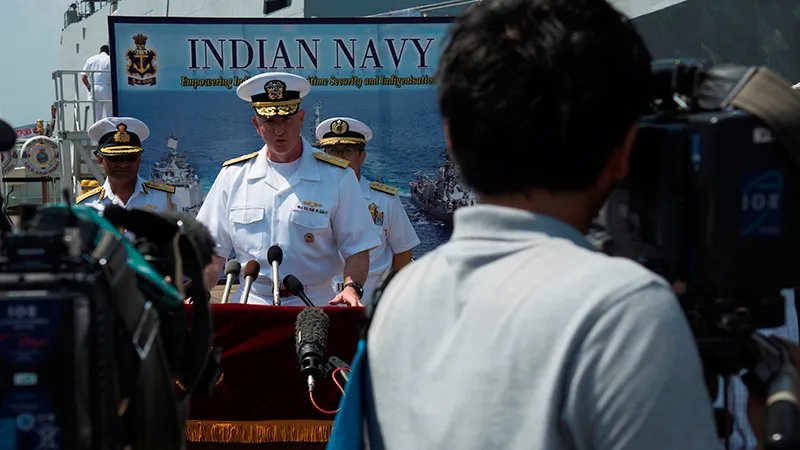Prime Minister Narendra Modi's successful visit to the US last week has generated discussion in India's strategic circles of the growing maritime intimacy between New Delhi and Washington.
Indian observers are enthused by the possibilities that have emerged as a result of the recent agreements between India and the US, in particular a maritime logistics pact and the resulting prospect of joint India-US naval operations. Indeed, with the India-US-Japan Malabar naval exercises in the seas of Okinawa timed to nearly coincide with Modi's Washington visit, there is speculation that Indian naval ships could soon join US-led operations in the wider-Asian littorals.
Two other pacts signed during the Modi visit — a white shipping agreement for the exchange of data on commercial shipping and a protocol of sensitive information exchange — have also been noted for their potential to improve India's maritime domain awareness in its regional waters. These agreements, commentators say, outline India's Indo-Pacific imperatives by emphasising its strategic interests in Southeast Asia, a pitch that chimes perfectly with Modi's Act East policy.
Indo-Pacific proponents draw attention to Defence Minister Manohar Parrikar's speech at the Shangri-La Dialogue last week where he described the region as critical space for India. Asia and Indian interests in it, Parrikar said, needed a consideration of the continent in its 'fullest geography, ranging from the Suez to the shores of the Pacific'. Predictably, his reference to the Indo-Pacific as the domain of India's 'Act-East' policy spurred claims of a fresh vigour in India's maritime policy.
These recent developments may have served to excite India's maritime analysts, but in and of themselves they do not constitute a correction to the traditional Indian thinking on maritime affairs in the Asia-Pacific. For discerning observers, Parrikar's speech in Singapore was a restatement of an old Indian position, packaged attractively to highlight 'optics' over 'substance'. As always, the idea was to underscore Indian 'interests' in Southeast Asia, while consciously side-stepping any discussion of polarising challenges in the region. In that respect, the Minister seemed to stick to the script, making general comments on the need for a peaceful resolution to the disputes in the South China Sea, but avoiding any references to China.
It isn't clear if Modi had a maritime-focused discussion during his visit to Washington, however, the India-US joint statement issued at the end of the Prime Minister's visit made no mention of the South China Sea, a significant omission in the eyes of many. Incidentally, New Delhi was unwilling to reveal contents of the discussions at the end of the first India-US maritime dialogue last month, presumably on account of a bureaucratic discomfort in flagging PLAN operations in the Indian Ocean.
India's avoidance of the issue of aggressive Chinese behavior highlights an essential contradiction in India's maritime relations with the US: despite a growing frankness in India-US maritime discussions, their bilateral dialogue mostly revolves around cooperative endeavors in the Indian Ocean. When the two do discuss Asia-Pacific affairs, India limits itself to outlining its economic interests in Southeast Asia. New Delhi offers Washington much rhetorical support for its Asia-Pacific endeavors, without ever agreeing to join naval operations in the South China Sea. At times, when enthusiastic American officials make radical proposals, New Delhi is prompt to issue an unceremonious rebuff. Admiral Harry Harris, the US Pacific Commander, learnt as much earlier this year when Manohar Parrikar rejected his suggestion for India-US joint patrols in the South China Sea.
In many ways, Parrikar's speech at Shangri-La was a reiteration of India's economic interests in the Asia-Pacific. As the Minister put it: 'with more than half of Indian trade passing through the South China Sea, New Delhi is keen to see the maritime disputes resolved peacefully without the threat or use of force'. More interesting was his suggestion states should to take a broader view of security, forging frameworks that 'promoted the societal well-being, seamless connectivity across the ocean'; the tacit implication is that regional disputes must not get in the way of open-commerce and the quest for prosperity. Plainly put, Parrikar was restating New Delhi's customary stance vis-à-vis the South China Sea: it is a maritime corridor crucial for international trade, but inconsequential for the purposes of determining the legitimacy of territorial claims. Indeed, India's position at Shangri-La, was neither based on maritime 'principles', nor part of a coherent and well-thought out strategy for the Asia Pacific. Rather, it was driven simply by the expedient considerations of trade and commerce.
The US maritime strategy for the Asia-Pacific region, on the other hand, seems premised on an expansive interpretation of international principles and maritime law. A look at US Defence Secretary Ashton Carter's address at the Singapore summit reveals the true extent of America's political vision for the region. The US, Carter effectively revealed, has a three-fold plan to deter Chinese aggression in the South China Sea.
The first element is that Washington has reinforced specific strategies that strengthen bilateral and trilateral arrangements. In this, Carter noted that the US had affected a strategic handshake with India, obtaining New Delhi's support for the US rebalance to Asia.
Second, the Obama Administration is helping US allies and partners bond together through specific initiatives. Carter spoke about India's developing ties with Japan and Vietnam, and its potential to strengthen regional security architecture.
Lastly, the US is working towards the creation of a fair and equitable multilateral order in which all its regional partners connect with each other through a 'principled networked security' approach that allows each of those nations to 'see more, share more, and do more for security in Southeast Asia'. This may sound ambitious (even utopian), but it amply demonstrates America's vision of a security network of states; nations building connections, planning and training together, and eventually engaging in coordinated operations.
What India's maritime mandarins often overlook is that maritime strategy isn't always led by the dictates and demands of economic interests. Sometimes nations must take a clear stand on issues of maritime principle on their merits alone. When the US urges its partners to isolate China, it wants this done regardless of the impact of Chinese transgressions on regional trade. Washington would like to see its allies and partners employ innovative measures to put pressure on Beijing for the creation of a new security order in which China affords equal respect to the rights and interests of other states. India, by contrast, gives the impression of being open to participation in a new regional order but not to participating in its creation
New Delhi's Indo-Pacific proponents who believe India has arrived as a maritime power in Asia should look at India's weak institutional links with its maritime partners in Southeast Asia. They will then realise that what seems like a courageous sail-by in waters claimed by China is actually a silent tip-toe into territory India regards as being manifestly contested.
This commentary originally appeared in The Interpreter.
The views expressed above belong to the author(s). ORF research and analyses now available on Telegram! Click here to access our curated content — blogs, longforms and interviews.




 PREV
PREV


